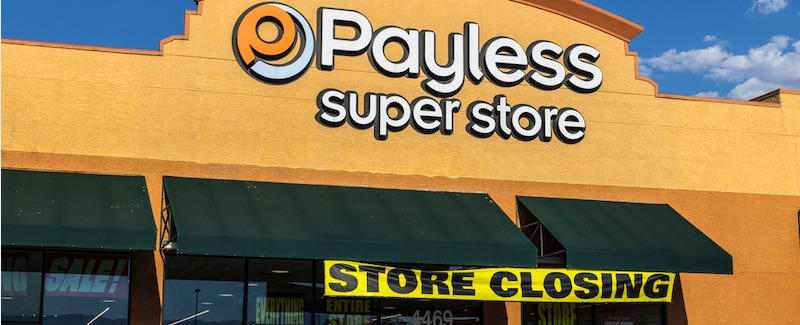
Retail store closures in the U.S. reached 9,302 in 2019. The biggest contributor was Payless ShoeSource, which declared bankruptcy and closed all of its 2,100 stores.
2019 was not a good year for brick-and-mortar stores. As of November 1, U.S. retail store closures reached 9,302, a 59 percent increase over 2018 according to Coresight Research. The biggest contributor was Payless ShoeSource, which declared bankruptcy and closed all of its 2,100 stores.
In “Is Experiential Retail Working?,” my April 2019 article, I cited Deborah Weinswig, founder and CEO of Coresight, who said she expected U. S. store closures to reach 12,000 by the end of the year.
Empty retail space is abundant — from suburban malls to midtown Manhattan. Analysts do not see a slowdown in closures as many stores are remaining open through the holiday season but will likely close in early 2020.
Coresight also reported that 4,392 stores, mostly in the non-apparel discount sector (Dollar General, Dollar Tree), opened in 2019. However, Family Dollar, which was acquired by Dollar Tree in 2015, closed almost 400 stores this year.
Bankruptcies
Many financially troubled chains started off the year by closing non-performing locations while trying to find investors or buyers. The weak position of these retail chains prevented them from securing financing, and many have filed for bankruptcy.
Apparel chains that declared bankruptcy in 2019 include Barney’s, Charlotte Russe, Dress Barn, and Forever 21. Kids clothing chain Gymboree filed for bankruptcy for a second time and liquidated all 805 stores. Discount department store Shopko filed for bankruptcy and closed over 371 stores. Fred’s, a discount chain, filed for bankruptcy in September and closed over 520 stores.
According to CreditRiskMonitor, J. Crew, Neiman Marcus, Pier 1, and J.C. Penney are among the retailers vulnerable to bankruptcy in 2020.
Omnichannel
An omnichannel approach to retailing is a necessity these days, and many retailers have struggled to implement one successfully. Online merchants have lower costs, fewer barriers to entry, and have proven to be more adept at leveraging social media.
In a telephone interview, Michael Brown, a partner in the consumer and retail practice at management consultant A.T. Kearney, shared his view that legacy brands do not have the DNA for social media; they are not as adept as online merchants. He said, “Core apparel brands are the ones having the most difficulty adapting to the new business model.”
Online merchants have lower costs, fewer barriers to entry, and have proven to be more adept at leveraging social media.
As for retailers, Brown says that small online niche merchants can attract a following on social media such as Instagram and take a small portion of market share from legacy retailers. “When you have 10 of these small players take 1 or 2 percent of the customer base, that’s when legacy retailers find themselves down 20 percent.”
He also faults retailers for not innovating. Larger retailers such as Target and Walmart have flexed their muscles in 2019, according to Brown, achieving a successful unified approach to sales and effectively competing against Amazon.
As for digital-first merchants that are now opening stores — Warby Parker, for instance, now has over 50 retail stores — Brown believes they will avoid the mistakes of legacy retailers. They will open more stores because they need the physical presence to scale their businesses. “The cost of customer acquisition online only is too expensive,” Brown stated.
The Long Term
Many analysts believe movie theaters, medical offices, and government offices will fill vacant mall space. In some areas, churches have taken up residence. Retail stores will have a smaller footprint. Some retail stores will be turned into marketplaces, providing small spaces for a variety of brands, especially direct-to-consumer goods. Pop-ups will also fill vacant mall locations.
Online retail sales in the U.S. now account for 16 percent of the total. But they will likely rise to 25 percent by 2026, investment banking firm UBS estimates. Under UBS’s “store rationalization” formula, each 1 percent increase in online sales, will result in 8,000 to 8,500 brick-and-mortar store closures. That could force up to 75,000 additional stores to close by 2026.
The stores under the most pressure are apparel outlets, as U.S. online apparel sales are expected to grow from 23 percent in 2019 to 36 percent by 2026. UBS recommends that clothing companies shutter a total of 20,700 retail locations by 2026 to avoid bankruptcy or other negative financial consequences.
Trade association National Retail Federation disputes these projections saying the math is overly simplistic and that UBS ignores the popularity of buying online and picking up in-store. Nevertheless, physical retail stores are in a precarious situation. More closures will likely occur.
December 26, 2019 at 08:48AM
via https://www.aiupnow.com
Marcia Kaplan, Khareem Sudlow
